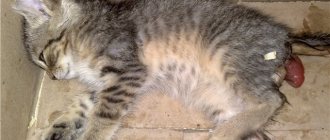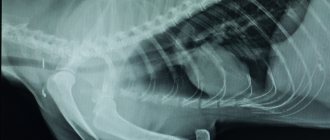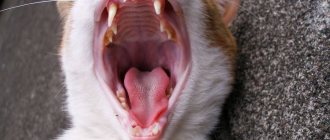How to treat
Ear mites, also known as otodectosis, are treated in different ways. Among the known methods, the following methods of struggle can be distinguished:
- insecticidal spray, and if ticks have spread to the body - drops on the withers;
- ear cleaner;
- drops;
- ointment.
If the choice is between drops or spray, then it is better to choose a spray. It can be used to treat not only a cat’s dirty ears, but also the animal’s main place of residence, for example, a box. If we talk about choosing a drug, then preference is given to such means as:
- Dermatosol.
- Psoroptol.
- Fipronil.
- Cyodrine.
In fact, the range of sprays against skin parasites is quite large. Therefore, the store will offer you something. There are no special priorities in this regard.
The main thing here is not to confuse ear mites with another disease. For example, a yeast infection in a cat’s ears produces similar symptoms – dark discharge (exudate). And the incorrect use of drugs against otodectosis can easily worsen the situation. For this reason, if you are unsure about something, go to the vet.
What you need to clean your ears
Many cats do not like the cleansing procedure; they may break out, scratch, hiss, and even bite. It is best to teach it from an early age, as cleaning a kitten’s ears is not difficult. A kitten whose ears have been cleaned since childhood, slowly and without sudden movements, has no fear of such a procedure. Some pets even like it, they close their eyes and lie quietly.
For stubborn adult animals, it is best to wrap them in a large towel or thin blanket. It is important that the cat does not have the opportunity to pull out its paws. This way you will not only make cleaning easy, but also protect yourself from deep scratches.
What you need for cleaning:
- cotton pads (sponges), they can be replaced with soft cotton cloth;
- cotton buds;
- a special lotion or gel for cleaning, which can be purchased at a veterinary pharmacy.
Since cleaning a cat’s ears at home sometimes needs to be done urgently, a special lotion can be replaced with vegetable oil or warm boiled water.
You should know that any cleanser is applied to a cotton pad. Under no circumstances should you drip it into a cat's ears.
Other causes of dirty ears
Some cat breeds have large ears, which are natural dust collectors. But even in an ordinary ear, dust accumulates over time and settles in the auricle. If too much dirt accumulates, the animal’s internal defenses come into play. This consists in increased secretion of earwax and, as a result, the formation of a dirty mass.
In some cases, the intensity of the work of the cerumen gland does not depend on external stimuli, so dirty ears can occur in cats that are constantly in a clean house. Most often, this phenomenon affects breeds that have no or little hair on their ears, but this is the animal’s natural protection from external influences. These ears need to be cleaned regularly.
Cats have dirty ears: reasons and what to do.
The diligence with which cats clean and lick themselves is worthy of the deepest respect and admiration. But despite all its phenomenal cleanliness, there remain some places that are difficult for the animals themselves to access, where they find it difficult to carry out hygiene procedures on their own. One of these difficult places for the tongue to penetrate is the inner surface of the ears. And here only a person can clean it.
Features of the problem.
If a cat's ears are constantly dirty, this should lead the owner to think that something is wrong with his pet's health. The presence of dirt inside the ear is often a consequence of some disease. In healthy cats, the inner surface of the ear has a pleasant light pink color. And even if a small amount of sulfur and dust has accumulated in them, they look quite healthy and well-groomed. In this case, nothing bothers the animal, it behaves calmly and adequately. However, a large accumulation of dirt inside the ear and the appearance of an unpleasant odor definitely indicate the presence of some kind of infection in the animal’s body. The most common source of ear contamination is ear mites. You should be very attentive to your pets, notice any deviations from the norm of behavior, because a cat’s constantly dirty ears can cause hearing problems in the near future.
Show increased interest in your pet at least once a week by thoroughly inspecting his ears and cleaning them of dirt. In order to avoid the accumulation of dirt, it is necessary to regularly carry out preventive measures. If, nevertheless, your kitten could not avoid this fate, do not try to cure it yourself - be sure to show it to a specialist and strictly follow his recommendations. Remember that self-medication can aggravate the disease and seriously harm your pet’s health.
Causes of dirt in the ears.
The main reasons for the accumulation of large amounts of dirt and wax in the ears of cats, as well as the discharge of pus, are such cat diseases as:
- Otodectosis, caused by ear mites. Constantly dirty ears of a cat become a provocateur for these parasites to attach to the outer ear canal and live there comfortably, feeding on the epidermis. As a result, fluid begins to ooze from the damaged areas of the ear. After drying, it turns into a dirty crust. Ticks can appear in a cat from contact with other animals that carry ticks.
- Otitis - can occur due to a head injury or infection. As a result of this disease, a sick animal secretes wax with pus, sometimes even blood, in the ear area.
- Allergic susceptibility.
- Infectious diseases of fungal, yeast and bacterial nature.
Other reasons.
Why do cats' ears become dirty? In some cases, the cause of contamination may be overly large ears. They accumulate much more dirt inside themselves than normal-sized hearing organs. In any case, medical procedures must be preceded by a qualified consultation with a veterinarian. Cats of hairless breeds may also accumulate more dust in their ears. For their ears are not at all protected by fur from various external influences. In Curls, the pinna faces outward, as if turned inside out, thereby collecting more dust than ordinary straight ears. A kitten's ears should be examined starting from two months of age. The first examination and decontamination session should be carried out by a veterinarian. You should also consult a doctor about how to clean your kitten’s ear correctly and painlessly. This will allow you to protect your baby from serious problems in the future.
What are ear mites in cats? Symptoms and treatment.
Excessive accumulation of wax in the ear can have a very negative effect on your pet's hearing and can also cause a plug to form. But the most common parasites that cause cats trouble are common parasites such as ear mites. We will talk about it separately. If your cat is shaking her ears and acting restless, that's good enough reason to get her checked for ear mites. This type of parasite is very common among domestic animals.
Algorithm for cleaning ears.
When adopting a pet, first consult your veterinarian on how to clean your kitten's ear when it gets dirty. There is a certain sequence of actions, following which you can carry out the hygiene procedure without any problems. To clean a kitten's ears, you need to do the following:
Your cat won't like having their ears cleaned. How to clean your ears correctly? To smooth out unpleasant sensations, pet your pet so that he relaxes. If the animal reacts calmly to treatment procedures, then simply lay it on its side, stroking it, bend the edge of the ear and drop a few drops of ear lotion (Otoklin, Bars, etc.) inside.
Wait a minute. Now lightly massage the cat's ears at the base until a characteristic squelching sound is heard. It indicates that the liquid has penetrated deep into the ear canal and softened the impurities. Now you need to carefully place a cotton tourniquet made in advance into the ear canal and move it from the inside to the outside. Cotton swabs should not be inserted into the ear canal! They can only be used to clean dirt in the folds of the outer ear. The cartilage plate with its many curves is cleaned last and especially carefully so as not to spread the infection deep into the ear.
If the kitten is obstinate, and you doubt whether you need to clean the ears of the little fighter, master the technique of cat swaddling. Before the procedure, wrap it in a towel or blanket to make the cat more comfortable. But so that he cannot pull out his paws and scratch you. Then you can safely carry out the procedure.
If your cat is sick and frequently scratches his ears, examine him and take him to the clinic. How to clean the ears of a sick animal? The veterinarian will advise this. For ear mites, for example, the frequency of the procedure is once every 5 days. This is necessary so that the tick does not spread further, but completely disappears. You need to provide proper care to your pet. In addition to the ear lotion prescribed by your veterinarian, you will also need the medication they recommend. Sometimes it's just drops. But if the case is severe or advanced, then antibiotics may be required to quickly cope with the problem and prevent relapse. A cat that is comfortable will not resist too much. But when it comes to instilling the medicine, be gentle with him. Usually the drops are quite caustic and can cause a burning sensation. To avoid having to forcefully calm the cat down, you should support the patient and feed him a treat after the procedure. Next time the cat will be loyal to cleaning.
Conclusion.
As we can see, a cat’s dirty ears are not a death sentence at all, but simply a signal for a more attentive attitude towards it. It is necessary to take measures to prevent the disease. Be vigilant, protect your pet from unpleasant diseases, and he will thank you with his boundless love and devotion!
In conclusion, I can say that Curl ears need cleaning more often than other breeds. Perhaps this is a breed “feature”. Due to their unique structure, curl ears are protected less than usual straight ears. We look into our ears more often. Some people need to clean their ears once a week, while for others once a month is enough.
I advise you to read more about caring for curlews in two topics on the forum:
— Dirty ears — problems for beginners and inexperienced vets ( -link- )
— About your favorite Curlo ears, ear care. ( -link- )
Based on materials from the site https://fb.ru/,
https://4lapki.com/ and personal observations.
How to properly scrub a cat's ears
The procedure for cleaning a pet's ears is a rather complicated task that requires compliance with certain rules. In (types of manipulation, you need to prepare the necessary material:
- Cotton swabs or tampons.
- Hydrogen peroxide syrup, but you can use a special gel.
- Lention for fixing the animal.
In principle, this arsenal of aids is amba for cleaning the ears. After you have prepared all of the above, you should do the following:
- Place the animal on a chair, securing it tightly with a towel.
- Hold the edge of your ear with your finger.
- Carefully examine the inner ear cavity of the animal.
- If you find deposits of dirt from the outside, carefully remove them using a peroxide-soaked swab.
- Then pour in a few drops of the drug prescribed by the veterinarian.
- You can sit for a while so that the liquid is evenly distributed; for this purpose, you can lightly massage the ear at the base.
- After this, you can carefully remove the dirt with a cotton swab.
- At the end of the procedure, use a cotton pad to blot off any remaining liquid.
For your cat's long-suffering and endurance, after cleaning its ears, it is worth giving it its favorite treat.
Important point: You should not benefit from any ear drops on your own without a doctor’s prescription.
Prevention
To protect your animal from such a problem as ear disease, you need to systematically follow simple tips:
- check your cat’s ears and clean them once every two weeks; this is not dangerous if you follow the veterinarian’s recommendations;
- buy lotion (for example, “Bars”), drops and cotton swabs at a special pharmacy;
- do not turn a blind eye to even the slightest signs of disease, because any little thing can seriously affect the health and life of the animal;
- be attentive to the cat, observe its habits and call a doctor if you have any suspicions.
For prevention, the drug most often prescribed is Revolution for Cats, which is easy to find in Moscow. It should be applied to the withers using the drop method.
After absorption into the skin, the active substance affects both ticks and fleas, if any.
Pet owners know that even ordinary dirt in the ear canal can be the first symptom of pathology. If you don’t delay full treatment, then everything will go well. But to avoid troubles, it is better to simply carry out prevention and constantly clean the animal’s ears.
Associated symptoms indicating pathology
In the case when the appearance of dark dirt in the ears of an adult cat or kitten is associated with dust, in order to get rid of it for 1-2 weeks, it is enough to wipe the pet’s ears with a damp cotton pad and clean the auricle with a cotton swab. However, if after cleansing the plaque quickly accumulates again, this is a sign of the development of pathology. The table describes symptoms that occur for various reasons.
| Pathology | Characteristic symptoms | Specific signs |
| Otodectosis |
| Gradually the brown coating turns black. As the disease progresses, a lot of dark dirt appears and purulent wounds form. |
| Otitis |
| As the pathology develops, the unpleasant odor becomes more intense. In the advanced stage, the cat begins to hear poorly. |
| Sulfur plug |
| After infection enters the ear, signs of otitis media are observed. |
| Allergy |
| With allergies, unpleasant symptoms disappear or become less noticeable in the absence of contact with the allergen. |
| Fungus |
| The pet's skin becomes dry, the coat loses its shine. |
| Necrosis |
| Gradually, the cat’s condition worsens, and deformation of the auricle appears. |
What to do if your cat has black dirt in his ear and itches
The main reasons for the accumulation of large amounts of dirt and wax in the ears of cats, as well as the discharge of pus, are such cat diseases as:
- Otodectosis, caused by ear mites. Constantly dirty ears of a cat become a provocateur for these parasites to attach to the outer ear canal and live there comfortably, feeding on the epidermis. As a result, fluid begins to ooze from the damaged areas of the ear. After drying, it turns into a dirty crust. Ticks can appear in a cat from contact with other animals that carry ticks.
- Otitis - can occur due to a head injury or infection. As a result of this disease, a sick animal secretes wax with pus, sometimes even blood, in the ear area.
- Allergic susceptibility.
- Infectious diseases of fungal, yeast and bacterial nature.
Otodectosis
- Otodectosis, or ear mite. The microscopic parasite penetrates the pet’s body through contact with a sick animal or its bedding and other household items. A person can also bring a tick into the house on their clothing or shoes. Penetrating into the auricle, the arthropod begins to feed on the epithelium, damaging the ear tissue. As a result of its vital activity, small wounds form on the upper integuments, from which liquid oozes, forming a dirty coating. Over time, the tick penetrates deeper, and bacteria begin to multiply in the resulting skin lesions.
Cat ears with ear mites
- Otitis. Develops as a result of infection of the auricle. The inflammatory process is provoked by: hypothermia, penetration of water into the ear, streptococci and staphylococci, microscopic injuries. Otitis develops in animals with low local or general immunity.
- Sulfur plug. Formed in a kitten or cat prone to increased sulfur secretion. This property is typical for sphinxes. In representatives of other breeds, wax plugs may appear due to lack of ear care, after severe stress, in the hot season.
Cat food allergy to food
- Allergies. One of the manifestations of an allergic reaction is the appearance of itching. Dark plaque on the ears appears due to the fact that the pet scratched the ear.
Black plaque in a cat's ear
- Fungus. Fungal spores do not often enter the ears of pets. However, when a cat occasionally visits the street, it can become infected through contact with a sick animal.
- Necrosis. It develops if, after an injury to the hearing organ, there is no treatment or an infection enters the wound.
Treatment is prescribed based on the diagnosis and accompanying symptoms. Before starting treatment procedures, the cat’s ears are cleaned of discharge. Use cotton swabs for cleaning. The plaque is first softened with Vaseline oil. It is necessary to remove accumulations formed on the surface of the ear, and discharge located at a depth of 1 cm in the auricle. Basic methods of treating cats at home.
Ear sanitation
| Disease | Main method of treatment | Additional events |
| Otodectosis |
| If an infection is added to the underlying pathology, the cat is prescribed antibiotics. |
| Otitis |
| Cleaning the ears with hydrogen peroxide, adding vitamin and mineral complexes to food. |
| Sulfur plug | If there is no infection, no specific treatment is required. | Softening sulfur plugs with hydrogen peroxide. Keeping your ears clean. |
| Allergy |
| In difficult cases, steroids are used. During treatment, the pet’s diet is strictly monitored. |
| Fungus |
| The use of antiallergic drugs that reduce the symptom of itching and painkillers. |
| Necrosis |
| Balanced diet, vitamins and minerals. |
The body of any living creature has unique characteristics. The appearance of dirt in the ear canals of a completely healthy cat is, for the most part, not a cause for concern. But sometimes this indicator means that the animal has a dangerous disease or that the inflammatory process of the hearing organ is rapidly developing. In normal condition, the inner part of a cat's ears has a light pinkish tint.
It makes sense to pay attention to this especially if the cat constantly shakes its head and scratches nearby ears. In such a case, you cannot do without the help of a veterinarian, since only a specialist is able to establish the true cause of the animal’s illness and determine the best option for dealing with the problem.
In some cases, accumulations of dirt, serous discharge, or pyothorax have appeared in the ears of a domestic cat; such pathological phenomena can be explained by the following factors:
- The development of otodectosis is a pathology, the arrival of which is most often provoked by ear mites. These parasitic microorganisms are firmly attached to the outside of the ear canal. Conforming to the fact that the main food of mites is skin, the skin inside the auricle is damaged, and liquid contents are released from the wounds. This secretion turns into mud when it dries. But the most important thing is that a healthy cat can become infected with a tick upon contact with a sick animal. These small parasites live even on the skin of human hands, and they are also not prohibited from being found on his clothes.
- During the course of otitis, one or the other most often develops as a result of infection. But this disease can be a consequence of an animal’s head injury. It is advisable to treat otitis media only after examining the animal by a veterinarian.
- An allergic manifestation to food or an external provoking factor.
- Infectious processes caused by fungi or other pathogenic microorganisms.
- Large animal ears. There are some cat breeds that are distinguished by their impressive ear sizes. Caste anatomical feature contributes to the accumulation of dust. When large amounts of dirt accumulate, the sulfur chamber intensifies. All these phenomena lead to significant contamination of the cat's ears.
- Wool deficiency. This feature is also observed in certain breeds of cats. As an example, it is allowed to cite the sphinxes. In cats of this breed, the ears are essentially devoid of hair, which makes the animal's hearing organ defenseless from any external negative influence. Pets of hairless breeds need to clean their ears with increased care.
We suggest you read: What are the names for Pekingese?
Owners of domestic cats should check the animal's ears from the age of two months. Moreover, this should be sprinkled regularly. It is best to have your kitten's ears cleaned for the first time at a veterinary clinic.
In this article I want to tell you why black dirt appears in a cat’s ear, symptoms of what diseases it can be, and how to treat these diseases if the animal is constantly itching. And most importantly, I’ll tell you how to avoid any problems with your pet’s ears and hearing through prevention.
Every owner of a cat or small kittens has at least once encountered the fact that brown dirt accumulates in the ears of his pet. The reasons for this vary from the fact that the cat simply got dirty somewhere, to quite serious diseases, such as otodectosis.
But even if the problem is just that the cat was unable to wash her ears (and it is difficult for her to reach them), this does not mean that everything can be left as is. It is urgent to remove accumulated dirt.
- Pre-wrapping the cat in a towel or blanket
- Soaking dried dirt with Vaseline or vegetable oil
- Using cotton swabs for babies to remove
- During the initial phase, the mass released from the shell is dry, like the surface of the ear itself. There is no scratching.
- At an advanced stage, the mass becomes more viscous, the ear becomes inflamed due to the appearance of colonies of fungi and bacteria.
If you find brown dirt again, then, unfortunately, we are faced with a sign of more serious problems, which I will discuss below.
Before cleaning the ears, the dirt must be soaked and cotton swabs for babies should be used.
The dirt that owners find in their cat's ears is not always brown. Often its color is closer to black. The presence of a substance of this color in the ear means that the cat is most likely sick.
What exactly depends on the symptoms, but there are three main problems that almost every pet owner can face.
This disease is caused by one of the most common parasites of cats - ear mites. Ear mites are arthropods that inhabit almost all ear canals and multiply rapidly.
It first settles in the outer ear. Having completely colonized it, the mite begins to colonize the medial and internal canals.
It is quite simple to determine that your cat has otodectosis - the brown plaque continues to accumulate even after its removal, which is why treatment must be started immediately.
Ear mite
When treating the first stage of the disease, it is enough to use Otodexin ear drops, aerosols and lotions. And the second requires the use of antibiotics and antimycotic agents.
How often should I clean? It depends on the breed of the animal, its state of health, its age and temperament.
Causes and diseases
The voluminous plaque that owners notice in the ear canal is not always brown. It is often black. The presence of a dark substance in the ear canal means that the pet is most likely sick.
What exactly depends on the symptoms, but there are three main problems that almost every owner can face. If a cat's ears itch inside, what should I do? It's natural to contact your veterinarian before it's too late.
Veterinarian help
It is necessary to seek help from a specialist if you have symptoms indicating an illness. When, a few days after cleaning, a cat again has dirt in the ear canal, this fact should alert you. This sign indicates the presence of otodectosis. Mites multiply very quickly in the auricle, which provokes the presence of dirt.
The appearance of scratches on the back of the ear canal also indicates mite activity. In this case, the animal is irritated, constantly tries to scratch its ears, and shakes its head. A specialist most often prescribes acaricidal drops against parasites.
Severely dirty ears in a cat, combined with other signs, may indicate otitis media. If there is inflammation, the pet's head is constantly lowered on one side, and the cat scratches its ears until it bleeds. You cannot do without the help of a veterinarian. For a mild form of the disease, a specialist prescribes drops, and in advanced cases, antibiotics.
If your pet is acting restless, you should visit the veterinarian immediately. In advanced cases, otitis media and otodectosis can cause deafness and other dangerous pathologies. Redness and inflammation of the ear in some cases indicates the presence of infections or allergies. If you undergo a course of treatment in a timely manner, it will not be difficult to cure the animal.
Do not forget that regular examination and cleaning of the hearing organ is a good opportunity to protect your pet from dangerous pathologies. It is recommended to visit a veterinarian and undergo an examination at least once every six months. In such a case, a specialist will be able to prevent the development of dangerous diseases.
We suggest you read: Why does a cat rub against your legs when it meets you?
As previously noted, consultation with a specialist is necessary when obvious symptoms of pathology appear. (or after the next cleaning, a few days later, dirt appeared in the cat’s ears again, then remove all grounds to suspect the presence of some kind of disease. Exit. Ant. The disappearance of scratches on the outside of the ear canal also indicates that not all The cat is in good health. The sign that has fallen off most likely indicates the appearance of ear parasites, in which case there are mites.
If your pet has developed otitis media, then the cat’s head will be constantly hanging down, and the sore ears will be scratched until they bleed. In such a situation, urgent veterinary treatment is needed to stop the inflammatory process. In advanced cases, the doctor usually prescribes antibiotics. Cats also need professional help if they have allergic reactions.
The owner of a domestic cat is obliged to take proper care of the animal. And cleaning and regular examination of the ears is also an excellent prevention of a number of diseases.











